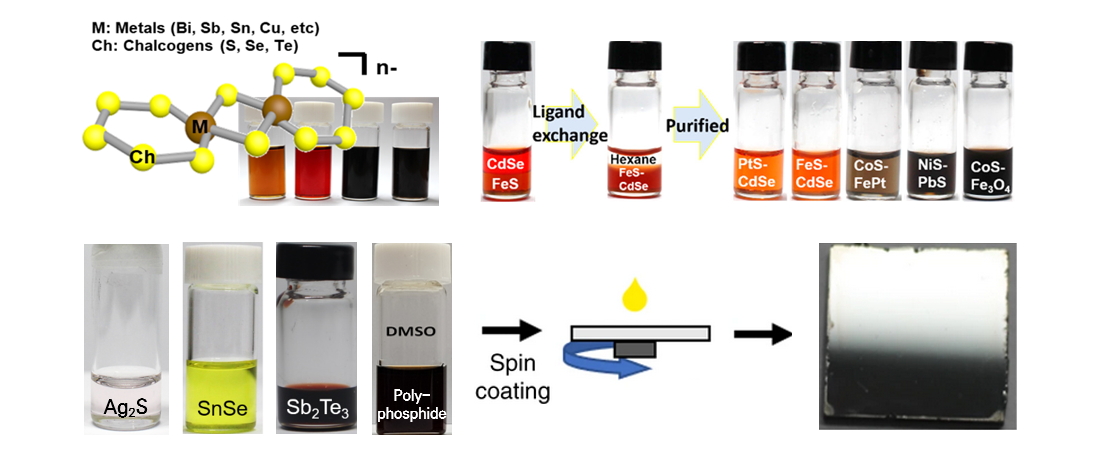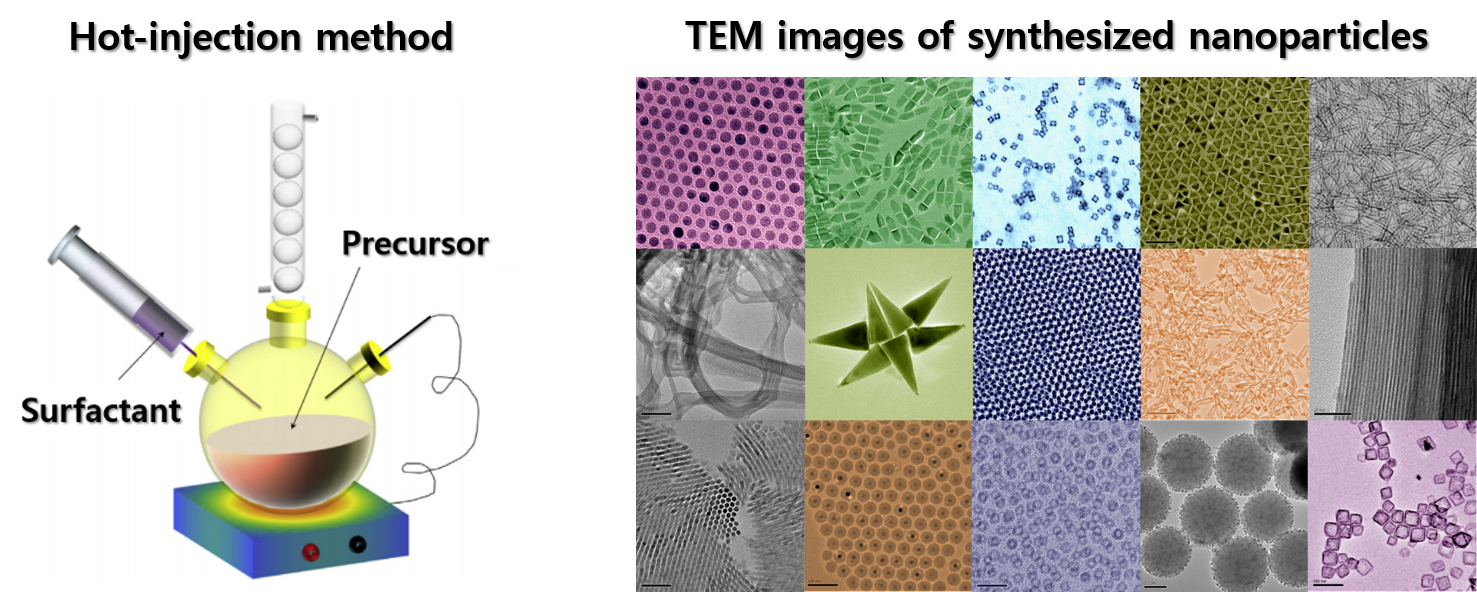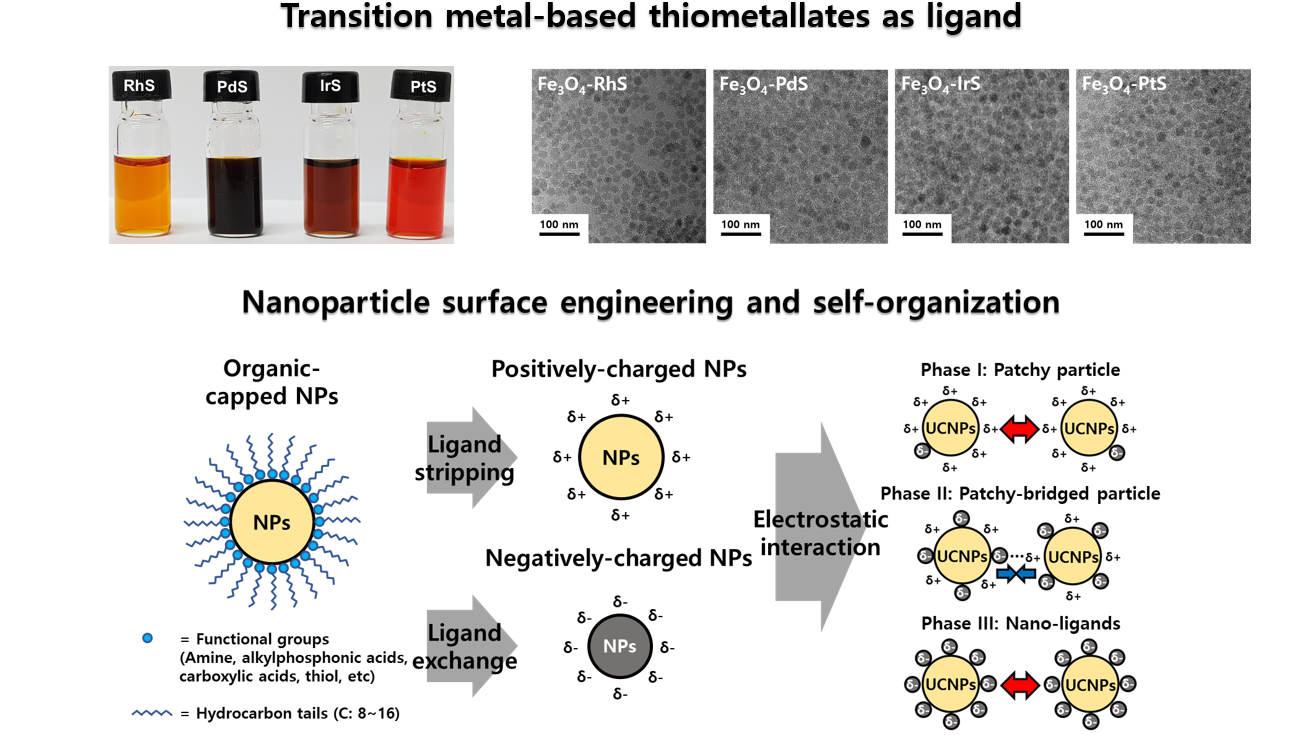Synthesis
Soluble inorganics
Facile dissolution of inorganics can offer a convenient route to exploit inorganic materials as sintering aids of mesoscale particles, ligands for nanoparticles and precursors for wet-chemical deposition of thin films. Inorganic materials can be directly dissolved in nucleophilic environment induced by excess chalcogen in hydrazine or deprotonated thiol in solvent mixture with amine. The nucleophiles in these solvents react with bulk inorganics breaking down them into molecular inorganic anions. Moreover, such inorganic molecules could be synthesized by traditional coordination chemistry route. We study for basic understanding on the role of molecular inorganics interacting with micro- and nano-scale building blocks, and utilize them for 2D or 3D architecturing of functional materials.
Facile dissolution of inorganics can offer a convenient route to exploit inorganic materials as sintering aids of mesoscale particles, ligands for nanoparticles and precursors for wet-chemical deposition of thin films. Inorganic materials can be directly dissolved in nucleophilic environment induced by excess chalcogen in hydrazine or deprotonated thiol in solvent mixture with amine. The nucleophiles in these solvents react with bulk inorganics breaking down them into molecular inorganic anions. Moreover, such inorganic molecules could be synthesized by traditional coordination chemistry route. We study for basic understanding on the role of molecular inorganics interacting with micro- and nano-scale building blocks, and utilize them for 2D or 3D architecturing of functional materials.

Relevant publication:
- Heo, et al. Composition change-driven texturing and doping in solution-processed SnSe thermoelectric thin films. Nature Commun. 2019, 10, 864.
- Jo, et al. Ink processing for thermoelectric materials and power generating devices. Adv. Mater. 2018, 1804930.
- Jeong, et al. Transition metal-based thiometallates as surface ligands for functionalization of all-inorganic nanocrystals. Chem. Mater. 2017, 29, 10510-10517.
- Zhang, et al. Soluble lead and bismuth chalcogenidometallates: Versatile solders for thermoelectric materials. Chem. Mater. 2017, 29, 6396–6404.
- Ban, et al. Molybdenum and Tungsten Sulfide Ligands for Versatile Functionalization of All-Inorganic Nanocrystals. J. Phys. Chem. Lett. 2016, 7, 3627-3635.
- Jo, et al. Simultaeneous improvement in electrical and thermal properties of interface-engineered BiSbTe nanostructured thermoelectric materials. J. Alloy. Compd. 2016, 689, 899-907.
- Park, et al. High performance shape-engineerable thermoelectric painting. Nat. Commun. 2016, 7, 13403.
- Donzhnikov, et al. Composition-matched molecular “solders” for semiconductors. Science 2015, 347, 425-428.
- Jo, et al. Ink processing for thermoelectric materials and power generating devices. Adv. Mater. 2018, 1804930.
- Jeong, et al. Transition metal-based thiometallates as surface ligands for functionalization of all-inorganic nanocrystals. Chem. Mater. 2017, 29, 10510-10517.
- Zhang, et al. Soluble lead and bismuth chalcogenidometallates: Versatile solders for thermoelectric materials. Chem. Mater. 2017, 29, 6396–6404.
- Ban, et al. Molybdenum and Tungsten Sulfide Ligands for Versatile Functionalization of All-Inorganic Nanocrystals. J. Phys. Chem. Lett. 2016, 7, 3627-3635.
- Jo, et al. Simultaeneous improvement in electrical and thermal properties of interface-engineered BiSbTe nanostructured thermoelectric materials. J. Alloy. Compd. 2016, 689, 899-907.
- Park, et al. High performance shape-engineerable thermoelectric painting. Nat. Commun. 2016, 7, 13403.
- Donzhnikov, et al. Composition-matched molecular “solders” for semiconductors. Science 2015, 347, 425-428.
Nanocrystals
Nanocrystals are crystals between 1 and 100 nm in size with a surrounding interfacial layer, attracting huge attention from various disciplines because of their unique properties which is different from conventional bulk materials, high surface to volume ratio and easily controllable properties by size, shape, and composition. These nanocrystals as building blocks affords “artificial atoms” to grow or to architecture designed solids with tailored electronic, magnetic, and optical properties. Following colloidal nanocrystal solution can be easily fabricated to solid-state device with various solution process across a wide range of applications like electronic, optoelectronics, catalyst, etc.
We have endeavored to synthesize various nanocrystals with different size, shape, and composition across various material types such as metals, semiconductors, and oxides by the colloidal chemical route to adopt nanocrystals as effective building blocks, and characterize those nanocrystals to observe changes in properties according to conditions.
Our goal is to fabricate multi-dimensional architectures through various processes using colloidal nanocrystal building blocks exhibiting unique and tailored properties.
Nanocrystals are crystals between 1 and 100 nm in size with a surrounding interfacial layer, attracting huge attention from various disciplines because of their unique properties which is different from conventional bulk materials, high surface to volume ratio and easily controllable properties by size, shape, and composition. These nanocrystals as building blocks affords “artificial atoms” to grow or to architecture designed solids with tailored electronic, magnetic, and optical properties. Following colloidal nanocrystal solution can be easily fabricated to solid-state device with various solution process across a wide range of applications like electronic, optoelectronics, catalyst, etc.
We have endeavored to synthesize various nanocrystals with different size, shape, and composition across various material types such as metals, semiconductors, and oxides by the colloidal chemical route to adopt nanocrystals as effective building blocks, and characterize those nanocrystals to observe changes in properties according to conditions.
Our goal is to fabricate multi-dimensional architectures through various processes using colloidal nanocrystal building blocks exhibiting unique and tailored properties.
We have endeavored to synthesize various nanocrystals with different size, shape, and composition across various material types such as metals, semiconductors, and oxides by the colloidal chemical route to adopt nanocrystals as effective building blocks, and characterize those nanocrystals to observe changes in properties according to conditions.
Our goal is to fabricate multi-dimensional architectures through various processes using colloidal nanocrystal building blocks exhibiting unique and tailored properties.

Relevant publication:
- Baek, et al. Controlled Grafting of Colloidal Nanoparticles on Graphene through Tailored Electrostatic Interaction. ACS Appl. Mater. Interfaces 2019, 11, 11824–11833.
- Choo, et al. Synthesis of Inorganic–Organic 2D CdSe Slab‐Diamine Quantum Nets. Small 2019, 15, 1804426.
- Jeong, et al. Technology Trend of Luminescent Nanomaterials. J. Korean Powder Metall. Inst. 2018, 25, 170-177.
- Bang, et al. Large-Scale Synthesis of Highly Luminescent InP@ZnS Quantum Dots Using Elemental Phosphorus Precursor. Chem. Mater. 2017, 29, 4236-4243.
- Gu, et al. Colloidal Synthesis of Te-Doped Bi Nanoparticles: Low-Temperature Charge Transport and Thermoelectric Properties. ACS Appl. Mater. Interfaces 2017, 9, 19143-19151.
- Yang, et al. Route to the Smallest Doped Semiconductor: Mn2+-Doped (CdSe)13Clusters. J. Am. Chem. Soc. 2015, 137, 12776-12779.
- Kim, et al. Near-Room Temperature Synthesis of Core/Shell-structured Quantum Dots. J. Nanosci. Nanotechnol. 2015, 15, 7146-7152.
- An, et al. Hollow MmOxPy and Pt/MoOxPy yolk/shell nanoparticles as a T1 MRI contrast. J. Colloid Interface Sci. 2015, 439, 134-138.
- Park, et al. Colloidal synthesis and thermoelectric properties of La-doped SrTiO3 nanoparticles. J. Mater. Chem. A 2014, 2, 4217-4224.
- Choo, et al. Synthesis of Inorganic–Organic 2D CdSe Slab‐Diamine Quantum Nets. Small 2019, 15, 1804426.
- Jeong, et al. Technology Trend of Luminescent Nanomaterials. J. Korean Powder Metall. Inst. 2018, 25, 170-177.
- Bang, et al. Large-Scale Synthesis of Highly Luminescent InP@ZnS Quantum Dots Using Elemental Phosphorus Precursor. Chem. Mater. 2017, 29, 4236-4243.
- Gu, et al. Colloidal Synthesis of Te-Doped Bi Nanoparticles: Low-Temperature Charge Transport and Thermoelectric Properties. ACS Appl. Mater. Interfaces 2017, 9, 19143-19151.
- Yang, et al. Route to the Smallest Doped Semiconductor: Mn2+-Doped (CdSe)13Clusters. J. Am. Chem. Soc. 2015, 137, 12776-12779.
- Kim, et al. Near-Room Temperature Synthesis of Core/Shell-structured Quantum Dots. J. Nanosci. Nanotechnol. 2015, 15, 7146-7152.
- An, et al. Hollow MmOxPy and Pt/MoOxPy yolk/shell nanoparticles as a T1 MRI contrast. J. Colloid Interface Sci. 2015, 439, 134-138.
- Park, et al. Colloidal synthesis and thermoelectric properties of La-doped SrTiO3 nanoparticles. J. Mater. Chem. A 2014, 2, 4217-4224.
Surface chemistry
One of the key parameters to synthesize robust and well crystalline nanocrystals of defined morphologies and function is the choice of surface ligands. Ligands play multiple roles ranging from the regulation of the solubility and availability of active components during NP synthesis to the post synthetic minimization of surface energy of nanocrystals (required for their colloidal stability) as well as the encoding of nanocrystals. We aim to chemically design the surfaces of nanocrystals by developing new-typed inorganic ligands for controlling over their functional properties as well as programming their many-body interactions in a solid. Designed nanomaterials can be applied to electronics, optoelectronics, catalysts, energy materials and 3D printing building block by processing.

Relevant publication:
- Baek, et al. Controlled Grafting of Colloidal Nanoparticles on Graphene through Tailored Electrostatic Interaction. ACS Appl. Mater. Interfaces. 2019, 11, 11824–11833.
- Zhang, et al, Soluble Lead and Bismuth Chalcogenidometallates: Versatile Solders for Thermoelectric Materials. Chem. Mater. 2017, 29, 6396–6404.
- Jeong, et al, Transition Metal-Based Thiometallates as Surface Ligands for Functionalization of All-Inorganic Nanocrystals. Chem. Mater. 2017, 29, 10510-10517.
- Ban, et al, Molybdenum and Tungsten Sulfide Ligands for Versatile Functionalization of All-Inorganic Nanocrystals. J. Phys. Chem. Lett. 2016, 7, 3627-3635.
- Donzhnikov, et al. Composition-matched molecular “solders” for semiconductors. Science. 2015, 347, 425-428.
One of the key parameters to synthesize robust and well crystalline nanocrystals of defined morphologies and function is the choice of surface ligands. Ligands play multiple roles ranging from the regulation of the solubility and availability of active components during NP synthesis to the post synthetic minimization of surface energy of nanocrystals (required for their colloidal stability) as well as the encoding of nanocrystals. We aim to chemically design the surfaces of nanocrystals by developing new-typed inorganic ligands for controlling over their functional properties as well as programming their many-body interactions in a solid. Designed nanomaterials can be applied to electronics, optoelectronics, catalysts, energy materials and 3D printing building block by processing.


Relevant publication:
- Baek, et al. Controlled Grafting of Colloidal Nanoparticles on Graphene through Tailored Electrostatic Interaction. ACS Appl. Mater. Interfaces. 2019, 11, 11824–11833.
- Zhang, et al, Soluble Lead and Bismuth Chalcogenidometallates: Versatile Solders for Thermoelectric Materials. Chem. Mater. 2017, 29, 6396–6404.
- Jeong, et al, Transition Metal-Based Thiometallates as Surface Ligands for Functionalization of All-Inorganic Nanocrystals. Chem. Mater. 2017, 29, 10510-10517.
- Ban, et al, Molybdenum and Tungsten Sulfide Ligands for Versatile Functionalization of All-Inorganic Nanocrystals. J. Phys. Chem. Lett. 2016, 7, 3627-3635.
- Donzhnikov, et al. Composition-matched molecular “solders” for semiconductors. Science. 2015, 347, 425-428.
- Zhang, et al, Soluble Lead and Bismuth Chalcogenidometallates: Versatile Solders for Thermoelectric Materials. Chem. Mater. 2017, 29, 6396–6404.
- Jeong, et al, Transition Metal-Based Thiometallates as Surface Ligands for Functionalization of All-Inorganic Nanocrystals. Chem. Mater. 2017, 29, 10510-10517.
- Ban, et al, Molybdenum and Tungsten Sulfide Ligands for Versatile Functionalization of All-Inorganic Nanocrystals. J. Phys. Chem. Lett. 2016, 7, 3627-3635.
- Donzhnikov, et al. Composition-matched molecular “solders” for semiconductors. Science. 2015, 347, 425-428.
